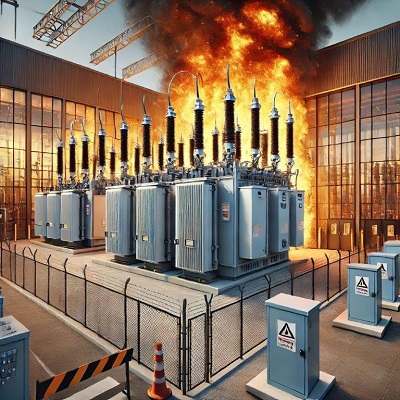Transformer protection is crucial in business environments because transformers are essential components in power distribution systems, stepping up or stepping down voltage levels to ensure efficient power transmission and distribution. Proper protection helps prevent faults such as overloading, short circuits, and internal failures, which can lead to significant equipment damage, costly downtime, and in some cases can cause system-wide outages, says Michael van Niekerk, CEO of ASP Fire.

He highlights the importance of transformer protection particularly in on-site power supply systems and notes that there are different types of transformers, some filled with non-flammable fluids, others with mineral oils, which are combustible, and dry-type transformers filled with gas. “The key is to ensure that there is enough safety distance, or there are fire-rated walls, between transformers and adjacent buildings, to prevent the spread of fire,” he explains.
Effective transformer protection minimises the risk of power outages and maintains continuous operations, reduces the risk of fire and other hazards associated with transformer failures, and prevents expensive repairs and replacements by mitigating damage early. It is also required in terms of industry standards and regulations.
Van Niekerk refers to the various South African standards and regulations that govern transformer protection and fire safety. For example, SANS 780 covers the requirements for distribution transformers, including design, construction, and testing. The South African Grid Code, administered by NERSA, includes guidelines for the protection and operation of electrical systems.
SANS 10142-1-2 is a wiring standard that outlines the requirements for electrical installations in South Africa. NRS 048 focuses on power quality and effective maintenance standards. “These standards ensure that electrical systems, including transformers, are designed and maintained to minimise risks and ensure safety and reliability.”
However, these SANS standards do not address the required safety distances between transformers – especially those filled with ignitable fluids – and important buildings or other important electrical equipment, nor the containment of ignitable oil that may leak from a transformer. International standards like the FM Global Property Loss Prevention Data Sheets provide specific guidance on the protection from or mitigation of transformer fire hazards.
Transformers with less than 1 900 litres of ignitable oil should not be located closer than 7.6 m from exposed combustible exterior walls or equipment. This can be reduced to 4.6 m where the external walls of the exposed building are non-combustible, like IBR sheeting, for example, or to 1.5 m where the external walls are fire-rated for two hours.
Vertical separation is equally important so the fire rated walls between the exposed building and the transformer need to extend to 7.6 m above the transformer where the building is constructed from non-fire rated walls.
Separation between adjacent transformers is also important. A minimum separation of 1.5 m between transformers with less than 1 900 litres of ignitable transformer fluid is recommended. A two-hour fire-rated barrier that extends 300 mm above the highest point where ignitable fluid is stored in the transformer can be built between adjacent transformers to provide adequate protection.
“ASP Fire can assist in designing passive and active fire protection for transformers and associated electrical equipment or buildings, including indoor and outdoor installations such as those in solar field installations or standby emergency power generation,” van Niekerk says.
For more information visit: www.aspfire.co.za